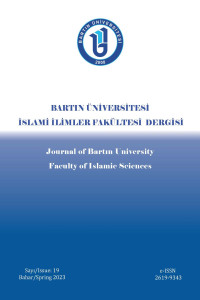Öz
Kaynakça
- Ebû Sa’d el-Muhassin b. Muhammed b. Kerrâme el-Hâkim el-Cüşemî. ‘Uyûni’l-mesâ’il fi’l-‘usûl. thk. Ramazan Yıldırım. Kahire: Dâru’l-ihsân, 2018.
Öz
Kaynakça
- Ebû Sa’d el-Muhassin b. Muhammed b. Kerrâme el-Hâkim el-Cüşemî. ‘Uyûni’l-mesâ’il fi’l-‘usûl. thk. Ramazan Yıldırım. Kahire: Dâru’l-ihsân, 2018.
Mu'tazilah Theology in the Post-Classical Period: Hakim al-Jushamī's Place and Views in Mu'tazilite Thought
Öz
The issues such as caliphate, accident, fate, and the status of the person who commits great sins that emerged in the Islamic society after the Prophet's death, and the philosophical groups encountered as a result of the spread of Islam to a wide geography as a result of conquests, constitute the basis for the emergence of Mu'tazilah. The Mu'tazilites were the source of the formation of the theology of the Ahl al-Sunnah with their holistic and systematic establishment of the issues pertaining to the faith. Especially names such as Abu 'Ali al-Jubbāʾī (d. 303/916) and Abu Hashim al-Jubbāʾī (d. 321/933), who represented the later period of the sect, and Qāḍī 'Abd al-Jabbār (d. 415/1025), who systematized the sect, are important for the development of Islamic thought. When one examines Qāḍī's extant works, one sees the last and final form of the sect. As a result of the sect's loss of political support after Qāḍī, Mu'tazila began to appeal to a narrower circle, but continued its vitality by integrating with Zaydī thought. The traces of this conclusion can be seen in Hakim al-Jushamī, who was the liaison between Qāḍī and Zamakhsharī (d. 538/1144), who was regarded as the last great imam of the Mu'tazila. In addition to his Zaydī identity, al-Jushamī (d. 494/1101) is worth analyzing in terms of showing the changes in the Mu'tazila after Qāḍī. The first study on al-Hākim al-Jushamī in Turkey was written by Ramazan Yıldırım in 2012 and published by Isaret Publications, entitled The Theological Polemics of the Mu'tazilites -Hākim al-Jushamī's Example-. Here, Yıldırım's work will be introduced and evaluated.
Anahtar Kelimeler
Kaynakça
- Ebû Sa’d el-Muhassin b. Muhammed b. Kerrâme el-Hâkim el-Cüşemî. ‘Uyûni’l-mesâ’il fi’l-‘usûl. thk. Ramazan Yıldırım. Kahire: Dâru’l-ihsân, 2018.
Öz
Hz. Peygamber’in vefatı akabinde İslam toplumunda ortaya çıkan hilafet, kaza ve kader ile büyük günah işleyen kişinin durumu gibi meseleler ve İslam’ın fetihler sonucu geniş bir coğrafyaya yayılması neticesinde karşılaşılan felsefî gruplar Mu'tezile'nin ortaya çıkışına zemin teşkil eder. Mu'tezile, itikada taalluk eden konuları bütüncül ve sistematik bir şekilde kurmasıyla Ehl-i Sünnet kelamının oluşumuna da kaynaklık eder. Özellikle mezhebin müteahhir dönemini temsil eden Ebu Ali el-Cübbâî (ö. 303/916) ve Ebu Haşim el-Cübbâî (ö. 321/933) ile mezhebi sistematize eden Kâdî Abdülcebbâr (ö. 415/1025) gibi isimler İslam düşüncesinin gelişimi açısından önemlidir. Zira Kâdî'nın günümüze ulaşan eserleri incelendiğinde mezhebin son ve mütekamil hali görülür. Kâdî'dan sonra mezhebin siyasî desteğini kaybetmesi neticesinde Mu'tezile daha dar bir çevreye hitap etmeye başlamakla birlikte Zeydî düşünce ile entegre olmak suretiyle canlılığını sürdürür. Bu neticenin izleri Kâdî ile Mu'tezile'nin son büyük imamı olarak görülen Zemahşerî (ö. 538/1144) arasındaki irtibatı sağlayan Hâkim el-Cüşemî'de görülür. Cüşemî (ö. 494/1101), Zeydî kimliğinin yanı sıra Kâdî'dan sonra Mu'tezile'nin değişimini göstermesi açısından incelenmeye değerdir. Hâkim el-Cüşemî hakkında Türkiye'de yapılmış ilk çalışma ise Ramazan Yıldırım tarafından 2012 yılında kaleme alınan ve İşaret Yayınları’nda basılan Mu’tezîle’nin Kelâmî Polemikleri -Hâkim el-Cüşemî Örneği- adlı eserdir. Burada, Yıldırım’ın eserinin tanıtım ve değerlendirmesi yapılacaktır.
Anahtar Kelimeler
Kaynakça
- Ebû Sa’d el-Muhassin b. Muhammed b. Kerrâme el-Hâkim el-Cüşemî. ‘Uyûni’l-mesâ’il fi’l-‘usûl. thk. Ramazan Yıldırım. Kahire: Dâru’l-ihsân, 2018.
Ayrıntılar
| Birincil Dil | Türkçe |
|---|---|
| Konular | Din, Toplum ve Kültür Araştırmaları |
| Bölüm | Kitap İncelemesi |
| Yazarlar | |
| Yayımlanma Tarihi | 30 Haziran 2023 |
| Gönderilme Tarihi | 6 Mayıs 2023 |
| Yayımlandığı Sayı | Yıl 2023 Sayı: 19 |
Bartın Üniversitesi İslami İlimler Fakültesi Dergisi Creative Commons Atıf-GayriTicari 4.0 (CC BY-NC) Uluslararası Lisansı ile lisanslanmıştır.
https://creativecommons.org/licenses/by-nc/4.0/



